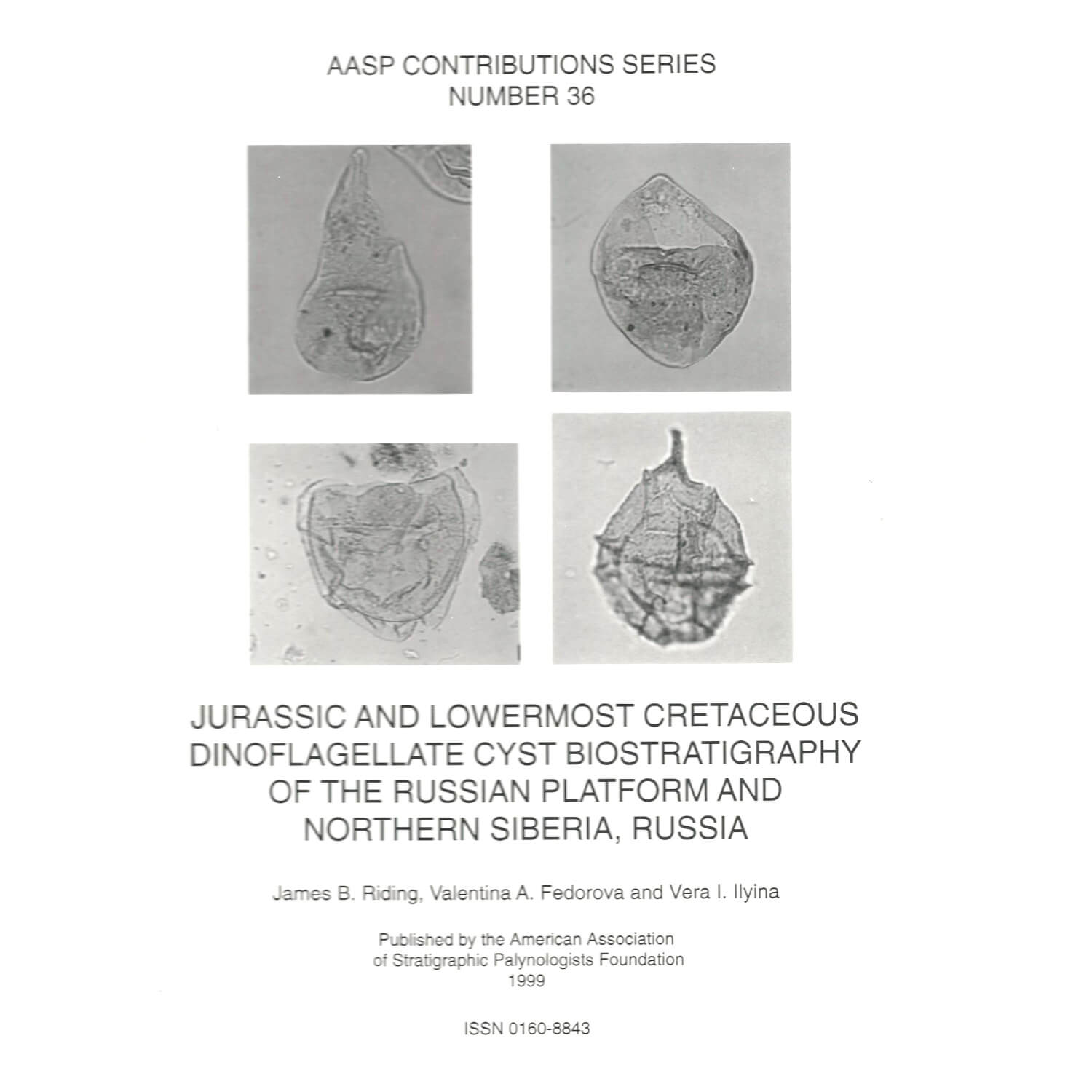Contributions Series Nr. 36
$20.00 – $24.00
Jurassic and Lowermost Cretaceous Dinoflagellate cyst Biostratigraphy of the Russian Platform and Northern Siberia, Russia
Riding, Federova, & Ilyina
1999
PDF & Hardcopy available
191 pp.
Description
Abstract
The Jurassic to lowermost Cretace0us (Upper Pliensbachian to Ryazanian) strata of the Russian Platform and northern East Siberia have yielded well preserved and diverse palynomorph assemblages, including abundant dinoflagellate cyst floras.
The uppermost Pliensbachian to Upper Toarcian of northern East Siberia produced abundant dinoflagellate cyst floras of relatively low species diversity. This interval is subdivided into three dinoflagellate cyst interval biozones, one of which is subdivided into & dinoflagellate cyst interval sub biozones. The genus Nannoceratopsis normally dominates the associations and is especially in he uppermost Pliensbachian and Lower Toarcian. The Parvocysta suite, including Phallocysta, is present
throughout the Upper Toarcian of this region. At certain horizons in the Upper Toarcian, Phallocysta eumekes is extremely abundant. The latter species and Valvaeodinium aquilonium are deemed to have Boreal affinities. The Lower Callovian of Anabar Bay yielded typically Boreal dinoflagellate cyst associations with prominent Crussolia dalei and Paragonyaulaysta retiphragmata. This isolated assemblage is not assigned to a dinoflagellate cyst interval biozone.
Bathon& to Ryazanian sections from the Russian Platform yielded abundant dinoflagellate cyst floras. These assemblages
from the central Russian Platform (Moscow-Volga Basin) and sections on the banks of the River Izhma and River Pizhrna in the
more northerly Pechora Basin are subdivided into eighteen dinoflagellate cyst interval biozones. The Bathonian dinoflagellate
cyst associations are of relatively low species diversity. Protobatioladinium elatmaensis and Protobatioladinium? elongatum
are biomarkers for the early-late and latest Bathonian respectively of the Russian Platform and appear to be endemic to this area. The Callovian and Oxfordian strata of the Russian Platform are characterised by abundant and diverse dinoflagellate cysts, many
species of which have wide geographical distributions throughout the Northern Hemisphere. In the early and mid Callovian, the
diversity is relatively low. Lower Callovian associations are interpreted to be mixed Boreal-Sub-Boreal and include prominent
Chytroeisphaeridia hyalina and Fromea tornatilis; Paragonyaulacysta retiphragmata is also present. However, from the late Callovian to the mid Oxfordian, dinoflagellate cyst increased markedly and the stratigraphic ranges of key taxa are virtually identical with those established throughout western and eastern Europe. These key taxa include Chytroeisphaeridia cerastes, Crussolia dalei, Ctenidodinium continuum and Scriniodinium cystallinum. At the Middle-Upper Oxfordian boundary, many Callovian-Oxfordian forms apparently became extinct. There is no similar species turnover at the Oxfordian-Kimmeridgian boundary and this situation is similar to that in western Europe. In the late Oxfordian, several typically Kimmeridgian elements emerged. Cribroperidinium globatum, Dingodinium spp. and Subtilisphaera? spp, are all common in the Kimmeridgian of the central Russian Platform. The late Oxfordian to Ryazanian of the Russian Platform typically yields lower diversity dinoflagellate cyst associations as compared with western Europe, however many taxa are present in both regions. These widespread forms include Glossodinium dimorphum, Gochteodinia villosa, Occisucysta balios, Oligosphaeridium patulum,
Perisseiasphaeridium pannosum and Senoniasphaera jurassica. Certain Upper Jurassic taxa appear to have younger range bases in the Russian Platform than in western Europe.
